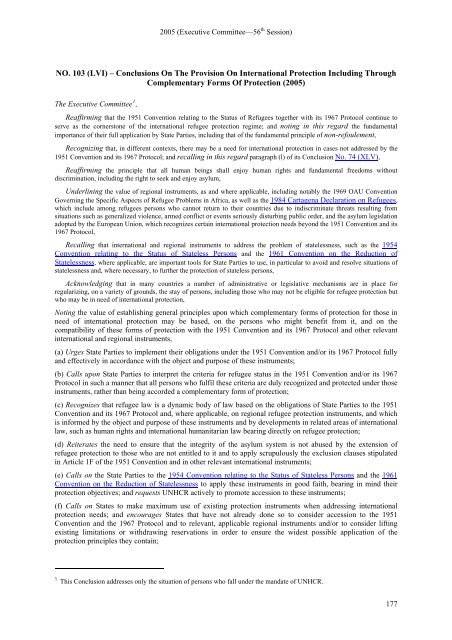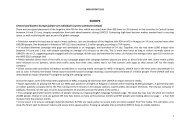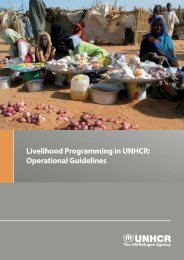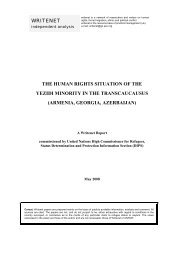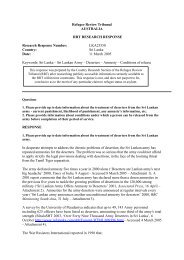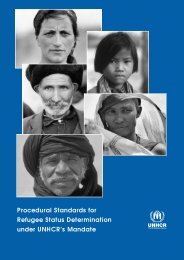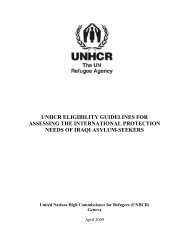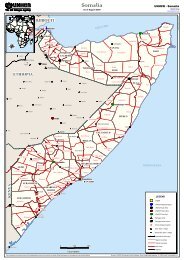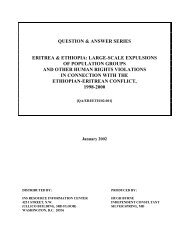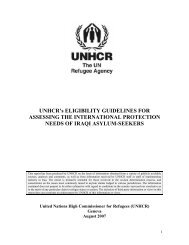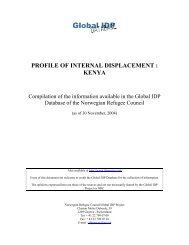CONCLUSIONS ADOPTED BY THE EXECUTIVE ... - UNHCR
CONCLUSIONS ADOPTED BY THE EXECUTIVE ... - UNHCR
CONCLUSIONS ADOPTED BY THE EXECUTIVE ... - UNHCR
You also want an ePaper? Increase the reach of your titles
YUMPU automatically turns print PDFs into web optimized ePapers that Google loves.
2005 (Executive Committee—56 th Session)<br />
NO. 103 (LVI) – Conclusions On The Provision On International Protection Including Through<br />
Complementary Forms Of Protection (2005)<br />
The Executive Committee 1 ,<br />
Reaffirming that the 1951 Convention relating to the Status of Refugees together with its 1967 Protocol continue to<br />
serve as the cornerstone of the international refugee protection regime; and noting in this regard the fundamental<br />
importance of their full application by State Parties, including that of the fundamental principle of non-refoulement,<br />
Recognizing that, in different contexts, there may be a need for international protection in cases not addressed by the<br />
1951 Convention and its 1967 Protocol; and recalling in this regard paragraph (l) of its Conclusion No. 74 (XLV),<br />
Reaffirming the principle that all human beings shall enjoy human rights and fundamental freedoms without<br />
discrimination, including the right to seek and enjoy asylum,<br />
Underlining the value of regional instruments, as and where applicable, including notably the 1969 OAU Convention<br />
Governing the Specific Aspects of Refugee Problems in Africa, as well as the 1984 Cartagena Declaration on Refugees,<br />
which include among refugees persons who cannot return to their countries due to indiscriminate threats resulting from<br />
situations such as generalized violence, armed conflict or events seriously disturbing public order, and the asylum legislation<br />
adopted by the European Union, which recognizes certain international protection needs beyond the 1951 Convention and its<br />
1967 Protocol,<br />
Recalling that international and regional instruments to address the problem of statelessness, such as the 1954<br />
Convention relating to the Status of Stateless Persons and the 1961 Convention on the Reduction of<br />
Statelessness, where applicable, are important tools for State Parties to use, in particular to avoid and resolve situations of<br />
statelessness and, where necessary, to further the protection of stateless persons,<br />
Acknowledging that in many countries a number of administrative or legislative mechanisms are in place for<br />
regularizing, on a variety of grounds, the stay of persons, including those who may not be eligible for refugee protection but<br />
who may be in need of international protection,<br />
Noting the value of establishing general principles upon which complementary forms of protection for those in<br />
need of international protection may be based, on the persons who might benefit from it, and on the<br />
compatibility of these forms of protection with the 1951 Convention and its 1967 Protocol and other relevant<br />
international and regional instruments,<br />
(a) Urges State Parties to implement their obligations under the 1951 Convention and/or its 1967 Protocol fully<br />
and effectively in accordance with the object and purpose of these instruments;<br />
(b) Calls upon State Parties to interpret the criteria for refugee status in the 1951 Convention and/or its 1967<br />
Protocol in such a manner that all persons who fulfil these criteria are duly recognized and protected under those<br />
instruments, rather than being accorded a complementary form of protection;<br />
(c) Recognizes that refugee law is a dynamic body of law based on the obligations of State Parties to the 1951<br />
Convention and its 1967 Protocol and, where applicable, on regional refugee protection instruments, and which<br />
is informed by the object and purpose of these instruments and by developments in related areas of international<br />
law, such as human rights and international humanitarian law bearing directly on refugee protection;<br />
(d) Reiterates the need to ensure that the integrity of the asylum system is not abused by the extension of<br />
refugee protection to those who are not entitled to it and to apply scrupulously the exclusion clauses stipulated<br />
in Article 1F of the 1951 Convention and in other relevant international instruments;<br />
(e) Calls on the State Parties to the 1954 Convention relating to the Status of Stateless Persons and the 1961<br />
Convention on the Reduction of Statelessness to apply these instruments in good faith, bearing in mind their<br />
protection objectives; and requests <strong>UNHCR</strong> actively to promote accession to these instruments;<br />
(f) Calls on States to make maximum use of existing protection instruments when addressing international<br />
protection needs; and encourages States that have not already done so to consider accession to the 1951<br />
Convention and the 1967 Protocol and to relevant, applicable regional instruments and/or to consider lifting<br />
existing limitations or withdrawing reservations in order to ensure the widest possible application of the<br />
protection principles they contain;<br />
1 This Conclusion addresses only the situation of persons who fall under the mandate of <strong>UNHCR</strong>.<br />
177


